This is the second in a series of write-ups of challenges from the Hack The Box Beginner Track.
In my first write-up, Lame, I talked about how capture the flag (CTF) challenges can generally be broken down into three phases: enumeration, gaining a foothold, and privilege escalation.
This challenge, Find The Easy Pass, is a bit different from a regular CTF, because there is no machine to break into. Instead, we're given a Windows executable file.
Leaving aside the question of whether it's safe to run random executables you downloaded from the internet, this is what appears when the file is launched:

Entering a possible password into the text box and clicking Check Password tells us whether we have the right password:
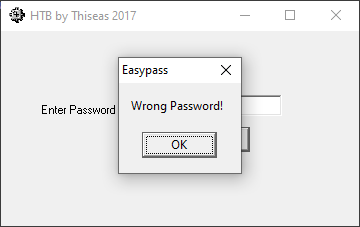
Given the name of the challenge, it's pretty clear that the password is the flag we have to find.
We have a program that we can use to test possible passwords, so in theory we could brute-force our way through all of them, assuming we had some way to automate the keyboard and mouse clicks. However, we have no idea what format the password takes. It could be six characters long and composed only of lowercase letters. It could also be fifty characters long and composed of uppercase and lowercase letters, numbers and special characters. We have no idea, and in the latter case there are more password combinations than there are atoms in the observable universe, so we can expect to be sat brute-forcing our way towards a solution for quite a while...
There's another quicker, more interesting way to tackle this problem. The program we've been given must contain some process to determine whether or not a given password is valid. If we can get a handle on this process, we might be able to use it to infer the password. We essentially need to reverse engineer the program we've been given.
Various tools exist to reverse engineer software, from disassemblers, which translate the raw binary content of an executable to assembly mnemonics, to decompilers, which attempt to reconstruct the program's original source code, to debuggers, which allow the execution flow of the program to be examined in real time.
For this challenge, I used the x64dbg debugger, partly because it's free and open source software (FOSS), and partly because I'd used it before.
My strategy for locating the password ran along the following lines: after the user enters a password and clicks the button to have it checked, that password must be stored in the program's memory somewhere. That memory must be read at some point prior to checking that the password is valid. If we can pause the program at the point where it reads this memory, maybe we can examine the program around this point, see where the candidate password is used and find the place where this password is compared to the password we need to extract.
I started by looking for possible Windows API calls that could be associated
with the appearance of the message stating whether the password was correct or
not. My first instinct was the
MessageBox
function, but using x64dbg's symbol filter suggested that this function wasn't
used. After a bit of digging around in the Windows API docs, I came across
CreateWindowExA,
which spawns a pop-up or child window and is used within the binary:
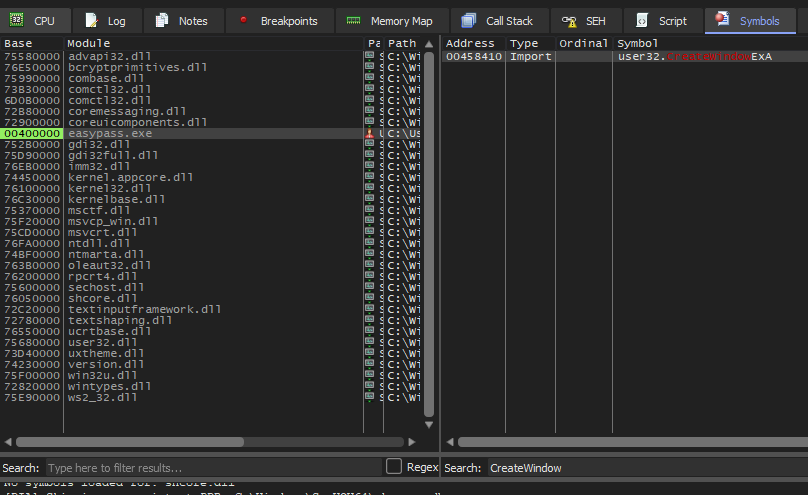
Setting a breakpoint on this symbol, I used the memory map pane to search for
the password after the breakpoint on CreateWindowExA was hit:
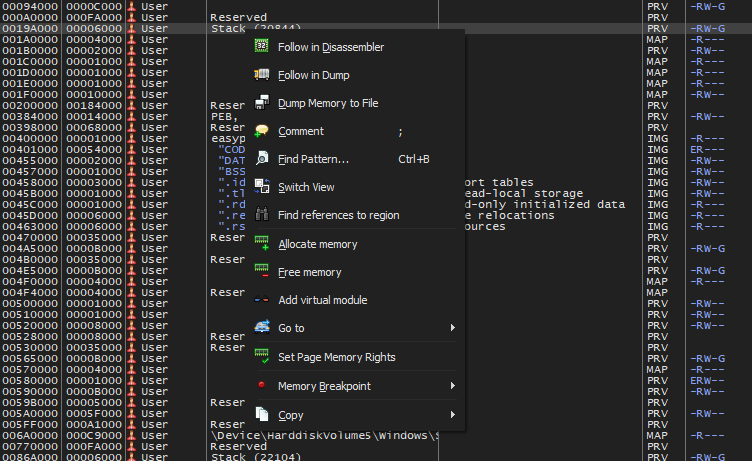
This gives us a dialog that we can use to search for arbitrary ASCII or UTF-8 strings. In this case we search for the ASCII password we've just entered:
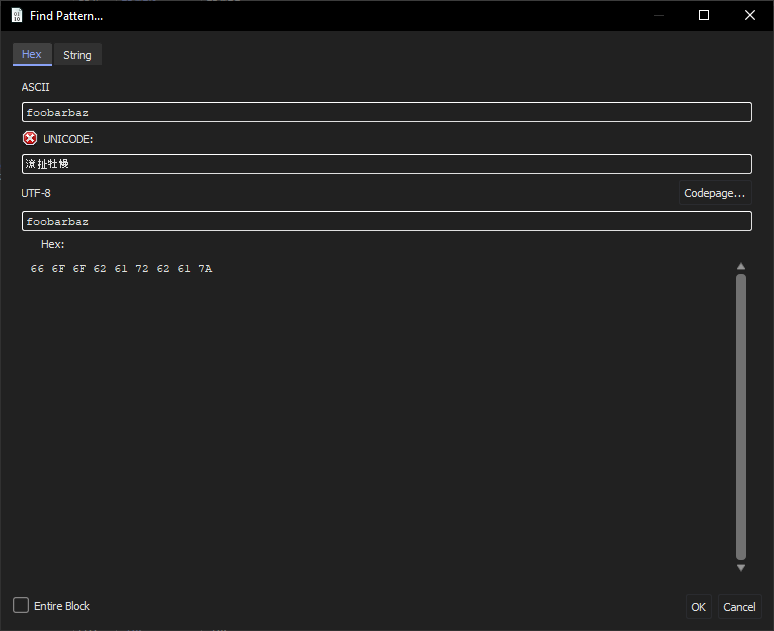
This reveals a couple of places where the password is referenced:
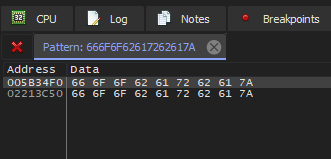
Examining these locations in the memory dump pane, x64dbg allows us to set a watchpoint on these memory addresses:
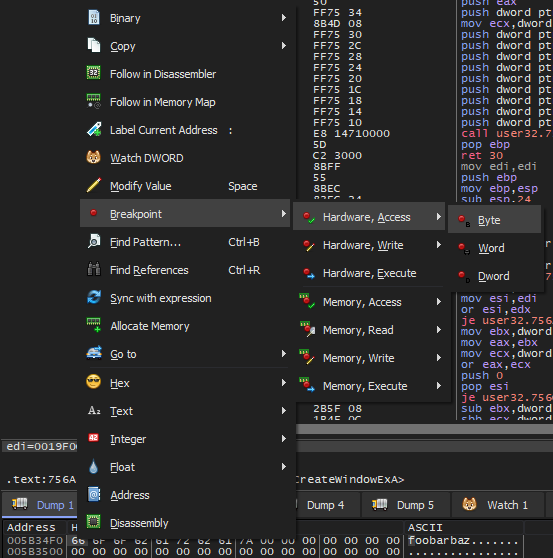
Entering the same password again, the watchpoint is triggered, and we see the password we've just entered to the right of the assembly listing:

At this point we can use x64dbg to examine the call stack and get a sense of where we are within the program:
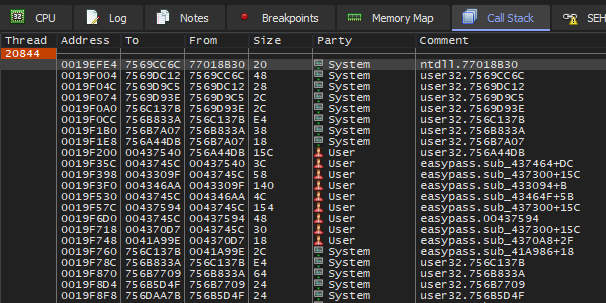
I'll be honest, this isn't particularly helpful. We could move around the various stack frames here to establish what will happen next, or we could just step through each instruction until we find the password comparison process. Taking the latter approach, we eventually arrive at this point in the program:

This looks promising. x64dbg has helpfully extracted the values pointed to by
various memory addresses and registers. Our candidate password, foobarbaz, is
located in on the stack forty (28 in hexadecimal) bytes below the base of the
current stack frame, which is stored in the stack base pointer register, ebp.
Another string, fortran!, is stored four bytes below ebp. The pointers for
these bits of memory are moved into registers eax and edx by the
instructions mov eax, dword ptr ss:[ebp-28] and
mov edx, dword ptr ss:[ebp-4], respectively, presumably in advance of a
comparison operation performed by the instruction call <easypass.sub_404628>.
Stepping through the next three instructions, we see this:

The program is now at a branching instruction, jne easypass.454144. jne
instructions tell the processor to jump to the specified instruction if a prior
comparison operation identified that the two operands weren't equal. In this
case we can assume that the comparison is the result of comparing the candidate
password with the actual password, probably by comparing the characters of the
two strings in sequence.
The instructions after the branching instruction refer to two strings. The second is the string we saw in the UI when we entered the incorrect password. The first must be the message we'll see when we enter the correct password.
In any case, it seems likely that "fortran!" is the password we're after. Trying this out confirms this:
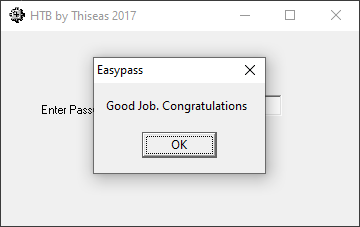
With that, we're all done!
In hindsight it would've been equally valid to search memory for the message that appears when we enter the wrong password. I've seen this approach used in other walkthroughs. I suspect that if the selection of the message were more removed from the password comparison process, maybe this approach would require more work. After identifying the place where the message is selected, you would then need to work backwards through the execution flow and find where the password comparison occurred. Fortunately the binary here doesn't make this necessary.